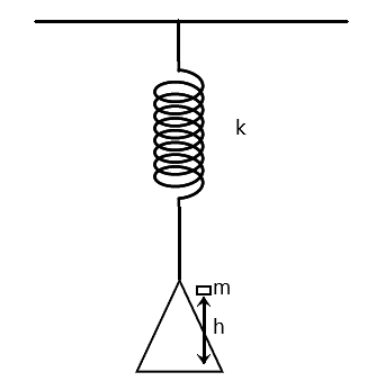Question
Question: A load of mass \[m\] falls from a height \[h\] on a scale pan hung from a spring as shown in the adj...
A load of mass m falls from a height h on a scale pan hung from a spring as shown in the adjoining figure. If the spring constant is k and mass of the scale pan is zero and the mass does not bounce relative to the pan, then the amplitude of vibration is:

Solution
At the farthest point of extension, the change in gravitational potential energy of the load must be equal to the elastic potential energy of the spring. The amplitude is the maximum initial extension minus the equilibrium position if the mass had been placed carefully on the pan
Formula used: In this solution we will be using the following formulae;
Es=21kx2 where Es is the energy stored in a spring, k is the spring constant, and x is the extension of the spring from initial position.
Ep=mgdwhereEp is the gravitational potential energy, m is the mass of the body g is acceleration due to gravity and d is displacement from a reference point.
x=2a−b±b2−4acwherex is the root (solution) of a quadratic equation given as ax2+bx+c=0.
Complete Step-by-Step solution:
Choosing the point of reference to be at the point of drop. Then the energy conservation at the farthest point of extension of the spring would be written as
mgh+mgx=21kx2 where m is the mass, g is acceleration due to gravity, h is the height of mass from pan, x is the initial extension of the string from original position and k is the spring constant of the spring.
Hence, by multiplying through by 2 and dividing through by k, then rearranging, we have
x2−k2mgx−k2mgh=0
We see that, this is a quadratic equation. Hence using the quadratic formula given by
x=2a−b±b2−4acfor a quadratic equation ax2+bx+c=0
Hence,
x=2(1)−(−k2mg)±(−k2mg)2−4(1)(−k2mgh)
⇒x=kmg±214(kmg)2+4(k2mgh)
We can factorise 4(kmg)2within the root, so we have
x=kmg±214(kmg)2(1+k2mgh)
⇒x=kmg±(kmg)1+k2mgh
Now, we see that the term after the ± is larger than the term before it. Hence, we can neglect the negative as in
x=kmg+(kmg)1+k2mgh
Now, amplitude would be equal to
A=x−x0wherex0 would be the equilibrium position.
The equilibrium position will be the point where the weight balances the spring force. i.e.
mg=kx0
⇒x0=kmg
Hence, by subtracting from x, we have
x=kmg+kmg1+k2mgh−kmg
⇒x=kmg1+k2mgh
Note: for clarity, the conservation of energy equation can be given as mgh+mgx=21kx2 for the following reason. Assuming the potential is zero at height h but increasing downward. The total energy at that point is hence,
Es+Ep+Ek=0whereEk is kinetic energy. Now, at the point where the mass just hit the pan, the mass gains energy isEs+Ep+Ek=−mgh+21mv2 (only potential and kinetic energy exist). At the point of maximum extension the total energy becomes Es+Ep+Ek=−mgh−mgx+21kx2 since kinetic energy would be zero. From conservation of energy, total energy is constant, hence
Es+Ep+Ek=−mgh−mgx+21kx2=0
⇒mgh+mgx=21kx2
note that the reference point of the potential energy is strictly for convenience, and it can be chosen from any point. But one must observe the convention that objects higher than the reference point have positive gravitational potential energy and objects lower than the reference point have negative potential energy.
